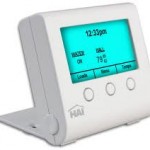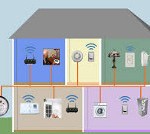Home automation is an emerging field with great potential, however without the appropriate standardisation of devices it can become a minefield of incompatibilities and frustrated customers. However there’s a standard we’re excited about – Zigbee Home Automation – that is quite promising.
ZigBee Home Automation is an application profile for Networked devices for home automation use – a global standard helping to create smarter homes that enhance comfort, convenience, security and energy management in the home environment. This standard for ZigBee wireless mesh-networked home automation applications can help make every home a smarter, safer and more energy efficient environment for consumers and families.
The standard gives your customers a way to gain greater control of the functionality of their home. By offering a global standard for interoperable products you it enables the secure and reliable monitoring and control of technologies in the home environment with robust, energy-efficient and easy to install wireless networks. Almost anything can be connected, such as appliances, home entertainment, environmental control and sensing, HVAC and security systems – providing convenience and energy efficiency benefits to the resident.
Smarter homes allow consumers to save money, be more environmentally aware, feel more secure and enjoy a variety of conveniences that make homes easier and less expensive to maintain. ZigBee Home Automation supports the needs of a diverse global ecosystem of stakeholders including home owners or tenants, product manufacturers, designers and architects, offering a standard that provides a reliable, consistent way to wirelessly monitor, control and automate household appliances and technologies to create innovative, functional and liveable home environments.
Typical application areas for ZigBee Home Automation can include smart lighting, access control, temperature and environmental sensing and control, intruder detection, smoke or fire detection, automated occupancy sensing and automated lighting or appliance control. The use of wireless radio networks eliminates the cost and effort of cable installation throughout the home, whilst the ZigBee standard provides certified interoperability and global 2.4 GHz ISM spectrum allocation, allowing manufacturers to take their ZigBee-based solutions to the global market relatively easily with relatively simple installation and operation.
Devices will have a typical RF range of up to 70 meters indoors or 400 meters outdoors, offering a flexibility to cover homes of all sizes. As with all ZigBee solutions, ZigBee Home Automation systems are built on top of an open and freely available specification based on international standards and represent a highly scalable solution with the ability to potentially network thousands of devices.
The devices are easy to install, even allowing for do-it-yourself installation in most cases. Employing wireless radio networks as well as battery power in many cases means that ZigBee Home Automation devices require little or no cable installation, making them ideal for easy retrofitting to existing homes and buildings as well as remodelling and new construction. Self-organising networks with easy device discovery simplify the setup and maintenance of networks consisting of many nodes, and the proven interference avoidance mechanisms in ZigBee networks ensure worry-free operation even in environments where coexistence with other 2.4 GHz radios such as 802.11 WiFi and Bluetooth is required.
The ZigBee Home Automation standard is designed for full coexistence with 2.4 GHz IEEE 802.11 wireless LANs and Bluetooth, as with all ZigBee technologies. Thus all devices based on these standards are designed to operate effectively in the same environment as WiFi networks, employing proven interference avoidance techniques such as channel agility.
Internet connectivity to the ZigBee network allows ZigBee Home Automation devices to be controlled via the Internet from anywhere in the world, as well as allowing WiFi-connected smartphones to be used as compact, powerful control and user-interface appliances to control the network of ZigBee appliances around the home.
Furthermore the standard is secure – employing AES128 encryption and device authentication to secure personal information, prevent unauthorised control of or access to the network, and to prevent interference or unauthorised access between independent neighbouring networks.
ZigBee Home Automation devices can be used to monitor household energy use, and to turn on and off devices remotely. Since ZigBee Home Automation is a ZigBee standard, ZigBee Home Automation devices will interoperate effortlessly with other products already in consumers’ homes using other ZigBee application profiles, such as ZigBee Light Link, ZigBee Remote Control, ZigBee Smart Energy or ZigBee Building Automation.
Finally – the standard is interoperable – integrating control and monitoring devices for lighting, security, home access and home appliances, allowing the customer to select from a variety of different products to meet her needs. All ZigBee-certified products are interoperable with each other and with other ZigBee networks, regardless of their manufacturer. All certified ZigBee devices, including but not limited to ZigBee Home Automation devices, from different vendors all use the same standards and are tested and certified to be fully interoperable with each other, allowing the consumer to purchase new devices with confidence.
With our existing experience in producing a wide range of devices incorporating Zigbee-based wireless technology our engineers can take your ideas for home automation to the final product stage.
We can create or tailor just about anything from a wireless temperature sensor to a complete Internet-enabled system for you – within your required time-frame and your budget. For more information or a confidential discussion about your ideas and how we can help bring them to life – click here to contact us, or telephone 1800 810 124.
LX is an award-winning electronics design company based in Sydney, Australia. LX services include full turnkey design, electronics, hardware, software and firmware design. LX specialises in embedded systems and wireless technologies design. https://lx-group.com.au
Published by LX Pty Ltd for itself and the LX Group of companies, including LX Design House, LX Solutions and LX Consulting, LX Innovations.


